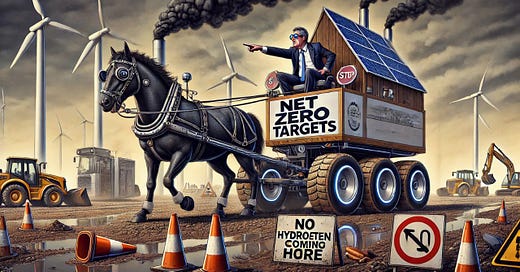When ambition outpaces reality
In our eagerness to hit our sustainability goals, are we in danger of putting the cart before the horse?
As the birthplace of the Industrial Revolution, the UK once reshaped the world through steam engines and coal.
Today, we’re trying to reshape it again; this time in the name of sustainability. We’ve shut down major coal power plants, set aggressive targets to stop petrol and diesel car sales, and now we’re extending that ambition to large-scale demolition and construction equipment. But what happens when policy ambition leaps ahead of viable technology and infrastructure?
That question should concern every operator, contractor, and fleet manager who struggles with equipment that simply isn’t ready to switch. And, frankly, it’s a question that should have been addressed already; long before these ambitious environmental targets were even set.
Consider the coal phase‑out. In late 2024, the UK finally closed its last coal‑fired power station; a watershed moment marking the end of 140 years of coal‑based energy.
And that transition was far from smooth. Despite the growth of renewable sources, the loss of our coal-fired power stations left us with an energy shortfall. On several occasions since, we have come desperately close to seeing the lights go out. Furthermore, we are still many years away from seeing our new nuclear power plants coming online to pick up the slack.
What about the rollout of electric vehicles? The UK has one of the highest growth rates in EV uptake, and public charging stations surged past 75,000 early this year. Yet still, the long-anticipated rapid charger fund was dropped and replaced with a smaller on-street charging scheme. While numbers continue to climb, many regions face delays, limited ultra-fast chargers at motorway services, and paralysis in local planning permits. The result is range anxiety and patchy deployment. People question whether the ladder we’re building can really hold the weight of targets set to 2030 and beyond.
And then there’s hydrogen; a future hope pitched for heavy transport, lorries, buses, and plant and machinery. Yet today, the UK has fewer than a dozen public hydrogen stations, mostly for cars and buses; not for construction sites or quarries. The technology is not perfected, is inefficient in production, and has safety concerns that remain unresolved. To sit back and say hydrogen will simply replace diesel on an active excavator is fantasy – at least it is today. The pump infrastructure, refuelling safety standards, and on-site handling protocols aren’t in place.
Now reflect on demolition and construction equipment. Governments talk confidently about non‑road mobile machinery bans and low‑emission zones for sites. Officials can recite the stats on EV car sales and train electrification; but they are largely unfamiliar with the demands of a 40‑tonne digger or the power draw of a dozer. They issue mandates as if battery‑electric excavators already exist commercially at scale, as if hydrogen‑powered wheel loaders were ready for hire. The truth is entirely different. Diesel machines are reliable, powerful, and they are known quantities. Current electric alternatives are expensive, offer limited lifespan per charge, and need substantial cooling and recharge time. Hydrogen prototypes are barely leaving test beds and come with enormous capital expense and safety hurdles.
This mismatch matters. When policy fails to align with reality, the consequences are clear: expensive equipment idles, critical projects stall, assets are prematurely retired, and equipment owners pay for upgrades that offer little benefit. In fact, when you weigh the cost of manufacturing a brand-new machine merely to satisfy an arbitrary environmental deadline, it is possible we might be doing more harm than good.
With so many perfectly good diesel-powered machines already in the field, this should not be an either/or argument. We (and by we, I mean the Government, the industry and society) should be focused not on stopping one fuel and starting another. We should be focused on a credible and achievable transition.
We should be using low-carbon diesel blends and biofuels now, delivering modest but meaningful emissions reductions.
We should be investing in hybrid and dual-fuel systems that offer immediate operational utility while lowering CO₂.
We should be developing site-level microgrids that combine solar, battery storage, and low-carbon backup generators. They reduce both emissions and grid dependency.
We should be piloting the real-world use of electric equipment, but doing so where grid supply is actually on-site, and study them rigorously to gather runtime, refuelling, and lifecycle data.
Finally – and it’s important to note that this is the last step – we must align policy with infrastructure: engage local grid operators, hydrogen producers, and site planners to ensure charger or hydrogen hub deployment is actually viable within realistic timelines before bans or levies take effect.
Sustainable progress demands more than symbolic targets. It requires a pragmatic, evidence-based ladder; each rung validated before we climb. Not every leap lands safely when the ground beneath isn’t ready. This article isn’t a rejection of net zero; it's a call for smarter support of credible paths. If we pair ambition with reality, demolition and construction can lead a transition grounded in working machinery, not in broken promises and missed targets.





